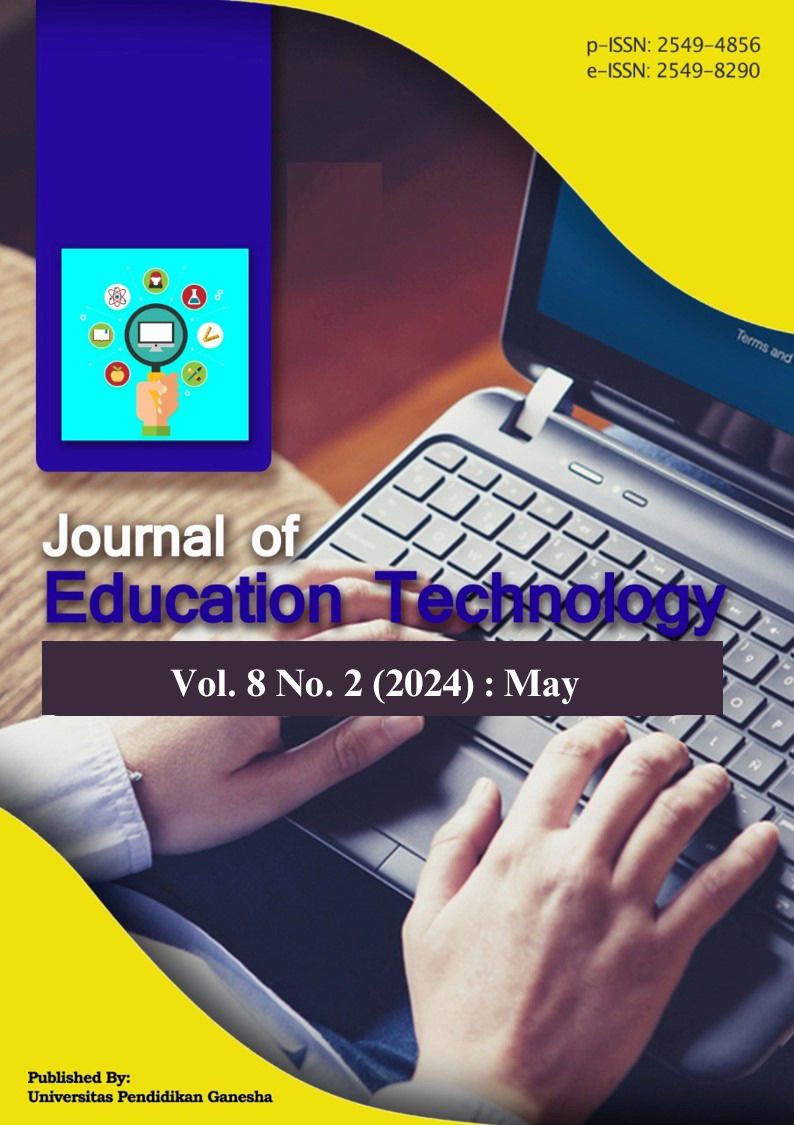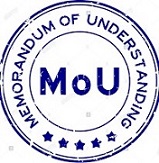E-learning Innovation for Generation Z in Higher Education
DOI:
https://doi.org/10.23887/jet.v8i2.70759Keywords:
E-Learning, Generation Z, Higher EducationAbstract
Research into the development of online learning for the OBE Photo Media Development course to support the implementation of independent campus learning, which the Indonesian Minister of Education and Culture has proclaimed. The purpose of this research is to develop online teaching materials for RPS-based OBE photo media development courses. This development uses the ADDIE development model. Development stages include Analysis, Design, Development, Implementation, and Evaluation. This development produces Online Teaching Materials for the Photo Media Development course that meet the rules and regulations of OBE lesson plan-based teaching materials. The subject of this research is a student of the Education Technology study program of Universitas Negeri Surabaya. Data analysis using interview and questionnaire methods. From the results of the product, validation was carried out by learning design experts, material experts, and media experts to determine the suitability of OBE lesson plan online teaching materials. The results of this research show that after carrying out a feasibility test, the test results obtained by media experts were 91.67% and material experts were 100%. The results of subject tests on Curriculum and Educational Technology students were taken from individual and small group trials. Three students in personal practices and small group trials by six students obtained respective results of 90% and 95%. The feasibility test results show that the online teaching materials based on the OBE lesson plan in the Photo Media Development course are declared feasible.
References
Ade‐Ojo, G. O., Markowski, M., Essex, R., Stiell, M., & Jameson, J. (2022). A systematic scoping review and textual narrative synthesis of physical and mixed‐reality simulation in pre‐service teacher training. Journal of Computer Assisted Learning, 38(3), 861–874. https://doi.org/10.1111/jcal.12653.
Almelhi, A. M. (2021). Effectiveness of the ADDIE Model within an E-Learning Environment in Developing Creative Writing in EFL Students. English Language Teaching, 14(2). https://doi.org/10.5539/elt.v14n2p20.
Ardiansah, F., & Miftakhi, D. R. (2020). Pengembangan Buku Ajar dengan Model Addie pada Mata Kuliah Manajemen Teknologi Pendidikan. Journal of Education and Instruction (JOEAI), 3(2). https://doi.org/10.31539/joeai.v3i2.1550.
Baran, E., Correia, A. P., & Thompson, A. (2011). Transforming online teaching practice: Critical analysis of the literature on the roles and competencies of online teachers. Distance Education, 32(3), 421–439. https://doi.org/10.1080/01587919.2011.610293.
Branch, R. M. (2009). Approach, Instructional Design: The ADDIE. In Department of Educational Psychology and Instructional Technology University of Georgia (Vol. 53, Issue 9).
Delita, F., Berutu, N., & Nofrion. (2022). Online Learning: The Effects Of Using E-Modules On Self-Efficacy, Motivation And Learning Outcomes. Turkish Online Journal of Distance Education, 23(4). https://doi.org/10.17718/tojde.1182760.
Dimas Pradana, H., Kristanto, A., Id, H. A., & Kunci, K. (2022). Fostering Students. In Independent Learning in Introduction to Learning Media Courses through Interactive Multimedia. http://jurnal.uns.ac.id/Teknodikahttp://jurnal.uns.ac.id/Teknodika.
Elmahdi, I., Al-Hattami, A., & Fawzi, H. (2018). Using Technology for Formative Assessment to Improve Students’ Learning. Turkish Online Journal of Educational Technology-TOJET, 17(2), 182–188. https://eric.ed.gov/?id=EJ1176157.
Fluck, A., & Dowden, T. (2011). On the cusp of change: Examining pre-service teachers’ beliefs about ICT and envisioning the digital classroom of the future. Journal of Computer Assisted Learning, 29(1), 1–10. https://doi.org/10.1111/j.1365-2729.2011.00464.x.
Greenier, V., & Moodie, I. (2021). Photo-narrative frames: Using visuals with narrative research in applied linguistics. System, 102(July), 102597. https://doi.org/10.1016/j.system.2021.102597.
Jaya, I. (2018). Penerapan Statistik Untuk Pendidikan. Prenadamedia Group.
Jukic, I., Prnjak, K., Zoellner, A., Tufano, J. J., Sekulic, D., & Salaj, S. (2019). The importance of fundamental motor skills in identifying differences in performance levels of u10 soccer players. Sports, 7(7), 1–11. https://doi.org/10.3390/sports7070178.
Kong, C. I., Welfare, J. G., Shenouda, H., Sanchez-Felix, O. R., Floyd, J. B., Hubal, R. C., Heneghan, J. S., & Lawrence, D. S. (2022). Virtually Bridging the Safety Gap between the Lecture Hall and the Research Laboratory. Journal of Chemical Education, 99(5). https://doi.org/10.1021/acs.jchemed.2c00096.
Kristanto, A., Sulistiowati, & Pradana, H. D. (2021). Brain-based online learning design in the disruptive era for students in university. Journal of Educational and Social Research, 11(6), 277–284. https://doi.org/10.36941/jesr-2021-0147.
Liu, X., Li, L., & Zhang, Z. (2017). Small Group Discussion as a Key Component in Online Assessment Training for Enhanced Student Learning in Web-based Peer Assessment. Assessment and Evaluation in Higher Education, 1–16. https://doi.org/10.1080/02602938.2017.1324018.
Malahayati, E. N., & Zunaidah, F. N. (2021). Analisis Kebutuhan Bahan Ajar Mata Kuliah Kurikulum. Jurnal Basicedu, 5(6). https://doi.org/10.31004/basicedu.v5i6.1802.
Mardikaningsih, A., & Kurniasari, P. (2019). Pengembangan Model Pembelajaran Blended Learning (Syncronous vs Asyncronous) Pendidikan Jasmani Kesehatan Dan Rekreasi. Madrosatuna: Journal of Islamic Elementary School, 3(1). https://doi.org/10.21070/madrosatuna.v3i1.1997.
Mardikaningsih, A., & Kurniasari, P. (2021). Developing Blended Learning Teaching Model through Online Social Media Platforms as Learning’s Support. Madrosatuna: Journal of Islamic Elementary School, 5(1). https://doi.org/10.21070/madrosatuna.v5i1.1389.
Megawati, C., Astini, D., Syahputra, I., & Zulkarnaini. (2022). Penggunaan Model ADDIE dalam Pengembangan Bahan Ajar. BAKTIMAS: Jurnal Pengabdian Masyarakat, 4(2). https://ojs.serambimekkah.ac.id/index.php/BAKTIMAS/article/view/4782.
Mentzakis, E., Tkacz, D., & Rivas, C. (2020). A proof-of-concept framework for the preference elicitation and evaluation of health informatics technologies: The online PRESENT patient experience dashboard as a case example. BMC Medical Informatics and Decision Making, 20(1). https://doi.org/10.1186/s12911-020-1098-z.
Muhammad Noor Sehabudin, A., Anggraeni, D., Mahliyadin, E., Rizkia, R., & Lestari, S. (2020). Model of OBE (Outcome-Based Education) curriculum and syllabus information system to support an independent campus in Indonesia. Journal Of Archaeology Of Egypt/Egyptology, 17(5). https://archives.palarch.nl/index.php/jae/article/download/2839/2759.
Muzaffar, A. W., Tahir, M., Anwar, M. W., Chaudry, Q., Mir, S. R., & Rasheed, Y. (2021). A systematic review of online exams solutions in e-learning: Techniques, tools, and global adoption. In IEEE Access (Vol. 9). https://doi.org/10.1109/ACCESS.2021.3060192.
Nasbey, H., & Raihanati, R. (2022). Developing a Video Education on the topic of Modern Physics Based on Problem Based Learning (PBL) assisted PhET Online Learning. Journal of Physics: Conference Series, 2377(1). https://doi.org/10.1088/1742-6596/2377/1/012067.
Navida, I., Fakhriyah, F., & Kironoratri, L. (2021). Pola Asuh Orang Tua Dalam Meningkatkan Motivasi Belajar Siswa Di Masa Pandemi. Jurnal Ilmiah Bina Edukasi, 14(1). https://doi.org/10.33557/jedukasi.v14i1.1366.
Nurhikmah, H., A., & Mahmud, Y. (2021). Pengembangan Video Tutorial Teknik Pengambilan Gambar Mata Kuliah Media Foto Untuk Mahasiswa Program Studi Teknologi Pendidikan Fakultas Ilmu Pendidikan Universitas Negeri Makassar. Jurnal Teknologi Pendidikan, 17(3). https://eprints.unm.ac.id/24017/.
Okwang, A. R., & Mwesigwa, D. (2022). Physical Facilities as Predictors of the Quality of Girls’ Education at Primary School Level in Oyam District, Lango sub-region, Uganda. American Journal of Creative Education, 5(2), 31–41. https://doi.org/10.55284/ajce.v5i2.778.
Ouyang, F., & Scharber, C. (2017). The influences of an experienced instructor’s discussion design and facilitation on an online learning community development: A social network analysis study. Internet High. Educ., 35, 34–47. https://doi.org/10.1016/j.iheduc.2017.07.002.
Perdana, Y., Djono, D., & Ediyono, S. (2018). The Implementation of Multicultural Education in History Learning At SMAN 3 Surakarta. International Journal of Multicultural and Multireligious Understanding, 5(3), 11. https://doi.org/10.18415/ijmmu.v5i3.135.
Pujiati, D., Basyar, M. A. K., & Wijayanti, A. (2022). Analisis Gerakan Literasi Sekolah di Sekolah Dasar. Pedagogik Journal of Islamic Elementary School, 5(1). https://doi.org/10.24256/pijies.v5i1.2615.
Resmayani, N. P. A., & Widaswara, R. Y. (2022). Promoting Engaging Interaction by Using Quizizz: An Option to Teach English During Pandemic Covid-19. Linguistics and ELT Journal, 10(2). https://doi.org/10.31764/leltj.v10i2.12412.
Sa’ida, N. (2021). Implementasi Model Pembelajaran STEAM Pada Pembelajaran Daring. Jurnal Review Pendidikan Dasar: Jurnal Kajian Pendidikan Dan Hasil Penelitian, 7(2), 123–128. https://doi.org/10.26740/jrpd.v7n2.p123-128.
Sisca, U. F., Pertiwi, P. H., & Rustandi, A. (2023). Peningkatan Keterampilan Menulis Teks Biografi Menggunakan Model Investigasi Kelompok Dengan Pemanfaatan Media Foto Pada Siswa Kelas X Smkn 3 Bandung. Didaktik : Jurnal Ilmiah PGSD STKIP Subang, 9(2). https://doi.org/10.36989/didaktik.v9i2.1213.
Su, C.-Y., Li, Y.-H., & Chen, C.-H. (2021). Understanding the Behavioural Patterns of University Teachers Toward Using a Learning Management System. International Journal of Emerging Technologies in Learning (IJET, 16(14), 129–145. https://doi.org/10.3991/ijet.v16i14.22685.
Susmita, N. (2022). Pengaruh Penggunaan Media Foto Berita terhadap Keterampilan Menulis Cerpen Siswa Kelas XI SMA. Jurnal Ilmiah Pendidik Indonesia, 1(2), 46–57. https://doi.org/10.56916/jipi.v1i2.167.
Syarhoh, U. M., Siddik, M., & Mulawarman, W. G. (2022). Pengaruh Penggunaan Media Foto dan Video Animasi Karikatur terhadap Kemampuan Peserta Didik dalam Memahami Teks Anekdot Siswa Kelas X SMA. Diglosia: Jurnal Kajian Bahasa, Sastra, Dan Pengajarannya, 5(3). https://doi.org/10.30872/diglosia.v5i3.443.
Tegeh, I. M., & Kirna, I. M. (2013). Pengembangan Bahan Ajar Metode Penelitian Pendidikan dengan ADDIE Model. Jurnal IKA, 11(1), 16. https://doi.org/10.23887/ika.v11i1.1145.
Teodorescu, D., Aivaz, K. A., & Amalfi, A. (2021). Factors affecting motivation in online courses during the COVID-19 pandemic: the experiences of students at a Romanian public university. European Journal of Higher Education. https://doi.org/10.1080/21568235.2021.1972024.
Umar, M. (2015). Riduwan,2009.Belajar Mudah Penelitian Untuk Guru,Karyawan dan Peneliti Pemula. Bandung:Alfabeta Sardiman. JURNAL EDUKASI: Jurnal Bimbingan Konseling, 1(1). https://abdimasuniversal.uniba-bpn.ac.id/index.php/abdimasuniversal/article/view/178.
Wang, X. (2022). Influences of Learning Emotion on Learning Outcome in Online Teaching Mode. International Journal of Emerging Technologies in Learning, 17(8). https://doi.org/10.3991/ijet.v17i08.30459.
Widiantari, L. P. Y., & Irwansyah, M. R. (2021). Implementasi Kurikulum 2013 Pada Mata Pelajaran IPS Di SMP Negeri 8 Singaraja. Jurnal Pendidikan Ekonomi Undiksha, 13(1). https://doi.org/10.23887/jjpe.v13i1.30918.
Winarni, R., Slamet, S. Y., & Syawaludin, A. (2022). Development of Indonesian language text books with multiculturalism and character education to improve traditional poetry writing skills. European Journal of Educational Research, 10(1), 455–466. https://doi.org/10.12973/EU-JER.10.1.455.
Zulkarnaini, M., C., A., D., & Syahputra, I. (2022). Penggunaan Model ADDIE dalam Pengembangan Bahan Ajar. BAKTIMAS: Jurnal Pengabdian Masyarakat, 4(2). https://ojs.serambimekkah.ac.id/index.php/BAKTIMAS/article/view/4782.
Downloads
Published
How to Cite
Issue
Section
License
Copyright (c) 2024 Lamijan Hadi Susarno, Utari Dewi, Khus Khotimah, Alim Sumarno, Andi Kristanto, Atan Pramana, Hirnanda Dimas Pradana

This work is licensed under a Creative Commons Attribution-ShareAlike 4.0 International License.
Authors who publish with the Journal of Education Technology agree to the following terms:
- Authors retain copyright and grant the journal the right of first publication with the work simultaneously licensed under a Creative Commons Attribution License (CC BY-SA 4.0) that allows others to share the work with an acknowledgment of the work's authorship and initial publication in this journal.
- Authors are able to enter into separate, additional contractual arrangements for the non-exclusive distribution of the journal's published version of the work (e.g., post it to an institutional repository or publish it in a book), with an acknowledgment of its initial publication in this journal.
- Authors are permitted and encouraged to post their work online (e.g., in institutional repositories or on their website) prior to and during the submission process, as it can lead to productive exchanges, as well as earlier and greater citation of published work. (See The Effect of Open Access)


















